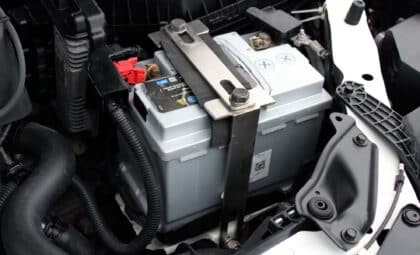
Formula 1’s governing body, the FIA, has decided to artificially slow down pit stops for the first time in the sport’s history. The average F1 pit stop is currently around 2.5 seconds, with times above three seconds considered slow and times below two seconds a relatively common occurrence in recent years. How have times gotten so fast and how have pit stops evolved from the beginning?
Related: Find the right tires for your car
The early years
The first F1 championship took place in 1950 and at the time, pit stops could take upward of a minute. Only two mechanics serviced the cars, using hammers to remove wheel nuts. The pit lane was directly adjacent to the track, potentially exposing the pit crew to cars racing wheel to wheel at upward of 180 mph.
When the stop was complete, mechanics often needed to push the car for a couple of yards to get it going again. Later on, a dedicated mechanic with a starter tool would be on standby in case the car stalled, though that role is now deprecated as modern F1 cars can be restarted independently by the driver, if needed.
In the 1950s, a pit stop lasting 25-30 seconds was considered a slick affair. But it would be a long time before pit stops were used strategically. During the first three decades of F1, the pit lane was almost exclusively a place to fix a problem like a puncture or broken front wing. Drivers only went into the pits if they had no other choice.
At the 1957 German Grand Prix, Juan Manuel Fangio became the first driver to intentionally pit for fuel and tires in the middle of a race. Though he eventually won, he would arguably have had an easier time by simply avoiding the stop altogether, and nobody tried the strategy again for a long time.
Related: Why is getting an oil change so important?
Pit stops as a strategy
It wasn’t until 1982 that pitting mid-race for fuel became commonplace. The Brabham team, whose car was very fuel-thirsty, realized that making a stop for fuel at the halfway point of the race could be advantageous. Less fuel means a lighter car and thus faster lap times, potentially offseting the time lost in the pits and then some. Additionally, changing tires while the car was getting refueled permitted Brabham to use a softer, faster compound.
By 1983, several teams had caught on and began doing the same. A year later, the FIA banned in-race refueling, but teams continued to strategically change tires. Without having to wait for refueling to complete, this led to faster pit stops. At the 1993 Belgian Grand Prix, Benetton performed a 3.2-second pit stop, a new record that eventually stood for over a decade and a half. It would be considered slow by today’s F1 standards.
Refueling was reintroduced in 1994, which increased pit stop times and likely allowed that Benetton record to last as long as it did. Even though teams developed systems that could refuel a car at a rate of more than 12 liters per second, refueling still took longer than changing all four tires.
Related: Comprehensive guide to the F1 ladder
The modern F1 pit stop
After one too many pit lane fires, the FIA finally banned refueling again after the 2009 season, leading to the modern F1 pit stop. Since then, everything about the pit stop has been about the tires. It’s very much like an orchestra or a dance, with upward of 20 mechanics all working in tandem to get the car going again as fast as possible.
The driver must stop on his marks so that the waiting pit crew members don’t have to waste time repositioning themselves. Two mechanics at the front and rear of the car use jacks to lift it. Four mechanics, one for each wheel, operate pneumatic wrenches (known as “wheel guns”) that remove the single locking lug nut keeping those wheels attached to the car. Four more mechanics then remove the wheels. Another four put the new wheels in place. The wheel gunners then tighten the lug nut on the new wheels.
Throughout this process, two mechanics on either side of the car ensure that it remains stable. Several mechanics may adjust the front wing angle to modify the handling of the car, or replace the front wing entirely if necessary. Ever since Jos Verstappen’s car went up in flames in 1994, a pit crew member stands by with a fire extinguisher.
More often than not, all of this takes place in the span of 2-3 seconds. Replacing the entire front wing can take about 10.
Related: 2021 Formula 1 schedule
Diminishing returns
Since 2010, pit stop times have gradually gone down, though process and equipment advancements are now deep into the realm of diminishing returns. Red Bull Racing currently holds the record for the fastest pit stop at 1.82 seconds, set at the 2019 Brazilian Grand Prix, and since that year, the average pit stop time has remained largely the same.
Today, the limiting factor is the human brain. During a pit stop, each wheel gunner must signal that every tire has been securely attached. When all four gunners have given the signal, the jack men lower the car, and the driver then gets the signal to exit the pit box.
Some teams and the FIA suspect that to speed up this process, Red Bull Racing has been using automated devices that remove the human element, such as a wheel gun that automatically sends out a positive signal when a lug nut is tightened. This could lead to malfunctions that would allow drivers to leave the pits before a wheel is properly attached.
The jury is still out on whether automated systems actually reduce safety, but the FIA seems to have made its decision by directing teams to slow down their stops by up to 0.35 seconds. That can be a long time in F1 and we’ll have to see how it shapes the rest of the championship, and how it influences the pit stop process in the future.
Kurt Verlin was born in France and lives in the United States. Throughout his life he was always told French was the language of romance, but it was English he fell in love with. He likes cats, music, cars, 30 Rock, Formula 1, and pretending to be a race car driver in simulators; but most of all, he just likes to write about it all. See more articles by Kurt.









